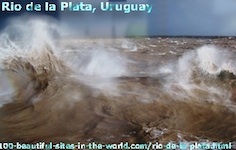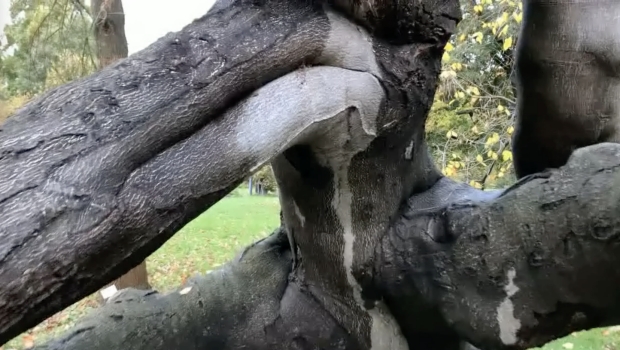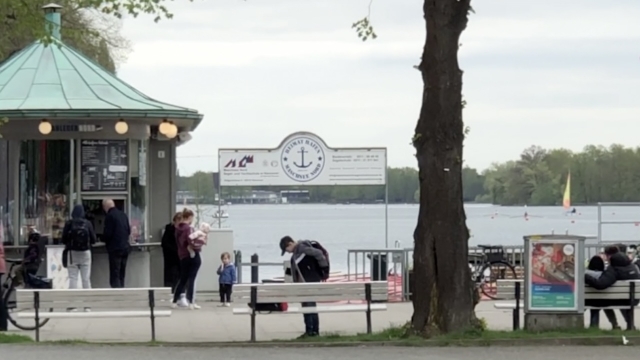Rio de la Plata, the River of Silver!
The Rio de la Plata's delicate balance of the ecosystem between freshwater and saltwater makes the area a natural home to rare species of dolphins, croakers and sea turtles.
How long could this exist during the recent climate change?
No one knows! If you knew, if you had been in the area or if you knew more information about it, please use the form at the bottom of this page to publish it. Thanks.

Many sources refer to the Rio de la Plata as Plata River, River Plate or the River of Silver. The drainage basin of the Rio de la Plata is about 4,144,000 square kilometres.
It is the second largest basin in South America and it makes about 25% of its surface. The basin covers southern and central Brazil, southeastern Bolivia, the entire nation of Paraguay, most of northern Argentina and Uruguay.
Different rivers feed the valley of Rio de la Plata, such as the Paraná River, the Paraguay River, and the Uruguay River, all of which has tributaries.
The confluence of Paranaiba River and Grande River forms the Parana River and makes it one of the longest rivers in the area. From the point of the confluence, it flows about 619 kilometres to the southwest towards the city of Saltos del Guaira, Paraguay.
The main tributaries of the Paraná River before it ends in the Paraná Delta are Gualeguay River, Tietê River, Paranaiba River, Grande River, Corumba River, Negro River, Paranapanema River, Carcarana River, Salado River and Iguazu River.
The Paraguay River covers almost 20% of South America and it runs in the entire nation of Paraguay, southeastern Bolivia, southern and central Brazil, northern Argentina and most of Uruguay.
The rivers confluence and make the Plata River one of the widest rivers in the world and it then extends 290 kilometres to the Atlantic Ocean. The river is 48 kilometres wide before the confluence and after it the river reaches 220 kilometres wide.
Every year 57 million cubic metres flow into the muddy estuary of Rio de la Plata, a coastal area with a lower salinity than the ocean.
The result of this flow is that fresh water from the Paraná River and Uruguay River collide together with the salt water from the southern Atlantic Ocean in a raging vortex caused by the strong southeastern winds, known as sudestadas and the changing tides.
At its widest point, the mouth of this immense estuary reaches 220 kilometres wide on the border between Uruguay and Argentina. It becomes the largest estuary in the world because it reaches this measure.
Argentina's capital Buenos Aires, a city founded by Pedro de Mendoza in the 16th century, around 1536 lies on the southern coast of the vast estuary. Uruguay's capital, Montevideo lies on the northeastern coast.
With its unique combination of saltwater and freshwater, the estuary keeps the soil in the surrounding landscape lush and fertile.
Rio de la Plata is a natural habitat to several endangered species such as sea turtles and the rare La Plata Dolphin, which is the only river dolphin that lives in the ocean and in saltwater estuaries.
The estuary is also home to the croakers. Those croakers are drum-fish that croaks like a frog. Every year from October to January, croakers migrate into the outer estuaries to spawn on the bottom of the water and eat mussels.
Weakfish or croakers have for generations been the main resource of food for the local Uruguayan fishermen, as well as the main food of the endangered La Plata dolphins.
The croakers are now under pressure from industrial fishing and pollution, and are also highly vulnerable to climate change.
In the future, it is likely that climate change will cause stronger winds, which in turn and together with the global sea level expected to rise higher, could lead to flooding of the Rio de la Plata coastal areas.
Not only that, but the flooding of the coastal areas will affect the delicate balance of the ecosystem between freshwater, destroy the croakers feeding ground and threat its very existence.
Have you been at Rio de la Plata, Uruguay? You can use the form below to write about this beautiful place in the world. Thanks for contribution.
Have A Great Story About Some Beautiful Sites in the World?
Do you have a great story about any beautiful site in the world? Share it!
What Other Visitors Have Said
Click below to see contributions from other visitors to this page...
STOP Corredor Bioceanico La Angostura URUGUAY! 




It is free important for the people to STOP Corredor Bioceánico La Angostura URUGUAY!
This is a post in reference to the decision to build a deep water …
All comments and articles about the Rio de la Plata appear at the second section of the page above this paragraph and below the form. If you did not comment or write article about the Rio de la Plata yet, please do that now. Thanks. You can get more information about beautiful Latinos sites at the right column.
In addition, you can share this page about Rio de la Plata, Uruguay with your services through the following buttons. Please do and enjoy those new technical experiences and social networking.
This page about Rio de la Plata is empowered by "Solo Build It" strong website building and optimizing tools on the image bar at the bottom of the page. Thanks to it.
100 Beautiful Sites in the World| 100 Beautiful Sites Blog| 100 Beautiful Sights| About Us| Beautiful Site Map| Beautiful Scene Newsletter| Contact Beautiful Sites| Any Beautiful City| Forward 100 Beautiful Cities| User Interface| 350| Aarhus| Aegean Sea| Altai Mountains| Amazon Rainforest| Amman| Archipelago Sea| Arctic Ocean| Battery| Bayan Olgii| Bay of Plenty| Beautiful Greek Islands| Beautiful Hotels in Orebro| Beautiful Orebro City| Beijing| Bering Sea| Big Sur| Boreal Forest| Borneo| Cape Floral Region| Caracas| Caribbean Sea Turtles| Chacaltaya| Chicago| Congo River Basin| Copenhagen| County Meath| Dalarna| Franz Josef Glacier| Ganges Delta| Gondar| Great Barrier Reef| Gujarat| Herschel Island| Hudson Bay| Ilulissat| Indus River| Kakadu| Kalahari Desert| Kauai| Kilimanjaro| Komodo Island| Kordofan| Lake Baikal| Lake Chad| Lilongwe| Love Covers Sweden| Madagascar| Mergui Archipelago| Mississippi River| Monteverde Cloud Forest| Naukluft Park| Niger Delta| North Slope| Norwegian Tundra| Nunavut| Nuwara Eliya| Okavango Delta| Olympia| Orebro Castle| Panama Canal| Paris| Perth| Quelccaya Ice Cap| Recife| Rio de la Plata| Ross Ice Shelf| Rotterdam| Rub al-Khali| Sagarmatha National Park| Saint Louis| Serengeti| Siberia| Solomon Islands| Sulu Sulawesi Sea| Thames| Tian Shan| Timbuktu| Tokyo| Trinidad| Tuvalu| Upper Po Valley| Valdes Peninsula| Vavau| Venice| Wadden Sea| Yamal Peninsula| Yangtze River| Zackenberg| Zahara de la Sierra|

